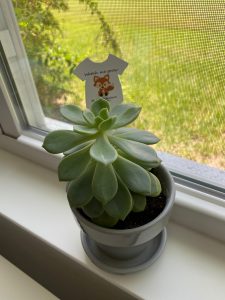How to Grow and Care for an Echeveria Plant
I’m wondering what type of plant food to use on a succulent I received as a gift for my daughter’s baby shower last year. Baby is now 15 months old, so this succulent is 16 months old. I can’t identify it more specifically. Perhaps you can, Judy. For size reference, the pot is 4” in diameter, 3.75” tall, and the plant is about 4” tall. Also does it need to be repotted into a larger pot again at this point? (It was about 2” when I got it, in about a 2” diam. pot.)
Thanks for your help, Judy.
Pamela Camboia
Hi Pamela,

Your plant is a succulent plant called an echeveria.
Light: These plants like as much bright light as you can provide (they can even handle several house of direct sun). During the summer you can even put them outside, but be sure to bring them in before nighttime temperatures go below 50°F (10°C).
Water: Echeveria plants require very little water. I usually wait until the soil has totally dried out and then water well enough so the water comes out the drip holes in the bottom of the pot. These plants easily develop root rot and die from over- watering. During the summer, when the plant is actively growing and producing new leaves, water a bit more often.
Plant Food: Succulent plants, like an Echeveria, are used to growing in very poor soil so they do not require much plant food. Feed the plant monthly during the spring and summer, but never during the spring and fall. I recommend using a fertilizer that is made specifically for succulents or cactus plants. If you do use a regular indoor plant food, be sure to dilute it to 1/4 the recommended strength to avoid what is called fertilizer burn.
Humidity: Echeverias are from dry desert areas and do well in regular household humidity. They will not do well in humid areas such as a bathroom.
Temperature: Basic household temperatures are fine. During the winter, keep an echeveria away from cold drafts and during the summer, away from air conditioners.
Soil: Cactus soil is best. If using regular potting soil, be sure to add some coarse sand to the mix.
Pot Size: Do not move the plant to a larger pot until the roots have filled the existing container. If the pot is too large, the soil stays wet too long, and the roots rot. There must always be drip holes in the bottom of the pot so excess water can escape; never allow the plant to sit in the excess water.
